
-
More on setting up interviews for choosing lens, (also mic and lighting purposes, seating heights..)
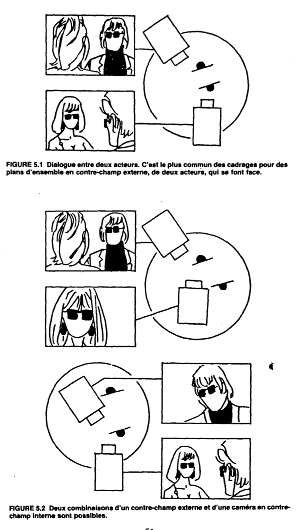
*from Daniel Arijon, "Grammaire du langage filmé"
Note:
- 2 cameras are cheap these days, no longer a real need to do a second take with same camera for "noddy" reverse shots of the interviewer;
- The other camera (or even a third) is needed for a 2-shot or "Master shot" from the front, for something to cut to if, say, the talent leans forward and out-of-frame to reach for a glass of water, or stand up, or make out-of-frame gestures;
- As @rambo says, the A-cam (MCU or CU of talent, shot over the interviewer's shoulder) needs to be locked-on. If the back of the' interviewer's head moves slightly into frame, partly obscuring the talent's face, the lens will hold its focus instead of focusing on the interviewer and blurring the talent.
-
Sounds like you might have to think on your feet. You'll probably do best with a tight-range zoom in those circumstances. Then you can concentrate on everything else. Also, the music interview genre certainly allows for a judicious zooming - in on the face, say when the talent has a tough question to answer!
Strangely, an 85mm equivalent focal length can come into its own in a noisy environment: you place yourself further from the talent, and although they're wearing a perfectly good lavalier mic a few inches from their face - and there might be a shotgun mic nearby, the talent will naturally tend to project their voice across the room to you - guaranteeing good sound levels, if at the expense of intimacy you'd get closer .
-
Keep in mind the Panny lenses do in-camera distortion corrections that isn't applied to non Panny lenses.
-
So it seems your 50mm is too long. Thus stick a Lens Turbo on your 50mm, and if that doesn't give you enough width get a Sigma 18-35mm f/1.8
-
@goanna - great video, thanks! Most examples teaching proper focal length focus only on the facial distortion. I liked how this video also showed how longer focal lengths pull the background forward. Shooting the video on a narrow street (instead of a plain background) was a wise choice to demonstrate how the appearance of the background changes.
-
The Appropriate focal length and distance should become instinctive. It's often a good exercise with media students to try to reproduce the shot sizes from footage of the same genre. Choose something fairly true to the medium and it's likely to have the right look. If your own talent and theme are something similar, just reverse-engineer somebody else's interview (Hey, there's no copyright on camera angles, go ahead!) Here's a fair -to-middling setup to copy if you ever need to interview a President ;-)
-
Why not using a Speedbooster and a prime lens? This way you can have 2 primes to choose from according to need/space. A 50mm could be used as a 60mm equivalent with the SB or as a 100mm eq using a normal adapter
-
Thank you for the replies people. As I'm interviewing musicians I'm at a lot of different venues, so I can have anywhere from 1 - 3/4 metres in distance away from the interviewee. So I need a lens that can handle tight spaces and look great with more room too. Is the 25mm not any good? How far away would you need to be from the subject with an 85mm?
-
Just as listeners can tell how close a microphone is being held to a sound source, the focal length is also a dead give-away. Each interview has a genre. A wide lens for @Rambo style (reality TV?) genre, A really long lens for a vox pop in the street where the subject needs to be isolated and the passing strangers blurred. Two seated people talking a metre and a half apart need the A camera pretty close with a 60mm equivalent lens. ENG crews in the field learn to get into this snug position within seconds and do it all day - with a zoom lens, of course, but almost always around the 60mm setting - and that's the look we associate with television news.
A M4/3 DSLR needs all the control it can get: if possible a 2-camera shoot, seating and a tripod, perhaps with a slider - And a good prime.
-
@goanna If you're talking about non mft lenses, that 35mm is just on the cusp of usable in terms of distortion. You're still going to have all the characteristics of the lens and nobody would ever use a 35mm lens on a 5d for example for MCU or CU interview stuff. If he's only going to use one and move back and forth, wouldn't a 50mm be a safer bet? I shot a pilot last year and when I went handheld, I wanted to of course go wide for stability but the widest we could go was the Rok 35mm on the BMCC due to it distorting faces and I was pretty far back, say maybe a medium on three people standing up.
Now if all the MFT lenses are designed just for the smaller sensors and the standard 35mm format and lens distortion does not apply, then that's a different ball game.
-
It's not a portrait. To stick with the one-on-one interview genre, use something close to a 60mm equiv. Shot just over the interviewer's shoulder, it flatters the face nicely and gets an eyeline close to the interviewer's POV while still conveying the impression of being close to the talent.
In micro 4/3, I like a Sigma 30mm. Yes, the Samyang 35 should be excellent.
-
@Rambo Always the up most respect sir!
As far as the ft difference, I get about 8ft at the most with an 85mm but like I said, we live in two different worlds :)
-
@vicharris, yep, don't ask me why i chose this style of work, it pays peanuts and ruins gear, but it is fun. Actually had the 20mm - 85mm scenario on the weekend in Perth WA. Here is a snapshot from the video with 20mm panny and the other a 85mm Canon on a 60D from another guy. I was 3ft away, the Canon guy was approx15ft. His audio failed so he borrowed mine, i had VMP on GH2 flashmount and separate backup audio Zoom H1 with Cheap lav stuffed down the guys shirt. You can see my hand in the frame on the right hand side of his shot. Canon looks soft hey?
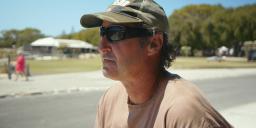
 Dean1.jpg1280 x 536 - 160K
Dean1.jpg1280 x 536 - 160K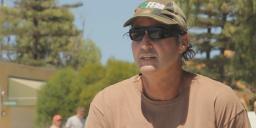
 Image3.jpg1280 x 536 - 144K
Image3.jpg1280 x 536 - 144K -
/\ Yet again I'm proven wrong :)
-
this is overkill for most small gigs, but i was working on a feature doc and wanted as many options as possible, so i used 3 cams for every interview, the panasonic/leica 25mm for a wide, an old zeiss contax 50mm f1.7 for a tighter shot, and finally the olympus 75mm for a really tight face shot for emotional close ups, etc. this sample image from the press kit shows some of the variety.
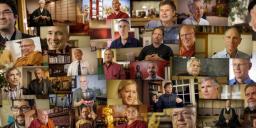
 Collages-960x350.jpg960 x 350 - 121K
Collages-960x350.jpg960 x 350 - 121K -
/\ :) I use a 24ish or 35mm for the wide and the 85mm for the CUs. Of course these are not mft lenses.
-
For sit down intv nothing handles the human features as well as an 85mm. Anything wider than 50mm can distort the human face depending on distance to subject. Even with the 2x crop factor I always try to get the longest focal length I can to avoid wide angle face distortions.
-
@Rambo Bro, all I can say is all of your experiences and work habits far exceed anything the regular guy does on a daily basis! You just get what you can when you can get it without a second just but still make it look damn good. :)
-
It also depends on the situation. If you have heaps of setup time in a controlled environment etc then sure go for it, use the technically correct equipment. However if the situations like, you've just leaped off the back of a jetski with your 2nd camera is deep inside 3 waterproof bags, you whip in out, rush over to the interviewee and say "hey can I talk to you about what you just did before you head off for a warm shower" a 20mm with variND and external mike works well in that situation, as it's opportunistic instantaneous live video capture and the interviewee won't walk off while you're fumbling with a big lens from 15ft away and wireless audio setup. For live events, it's ideal, but so is a camcorder. Just don't ask me to shoot a wedding, those guys have my respect.
-
85mm on m43 looks good for the close up shot (neck and face). 35~50mm on m43 seems good enough for medium close up shot (chest up). I meant the shortest focal length with very negligible perspective distortion. But I see the point of Rambo about 20mm 1.7.
-
It's not crap, you just need the room to use it (not always the case on some crappy office where I'm forced to shoot no matter what I say about scooting for a better place) :-) But when you have the room, it's aesthetically perfect (and less impressive for the talent)
-
Yeah, an 85mm is crap for CUs and talking head stuff :)
-
BMCC and Rokinon 85mm
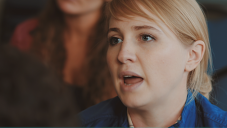
 Screen Shot 2013-11-02 at 11.05.25 PM copy.png504 x 284 - 233K
Screen Shot 2013-11-02 at 11.05.25 PM copy.png504 x 284 - 233K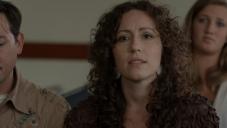
 Untitled_1.7.1.jpg504 x 284 - 33K
Untitled_1.7.1.jpg504 x 284 - 33K -
GH2 and Rokinon 85mm.
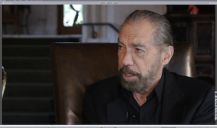
 Screen shot 2012-10-13 at 3.27.05 PM 2 copy.png504 x 297 - 259K
Screen shot 2012-10-13 at 3.27.05 PM 2 copy.png504 x 297 - 259K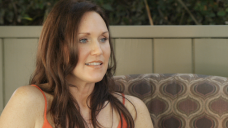
 Screen Shot 2014-01-21 at 4.01.40 PM.png504 x 283 - 283K
Screen Shot 2014-01-21 at 4.01.40 PM.png504 x 283 - 283K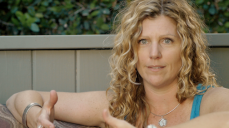
 Screen Shot 2013-10-14 at 2.09.45 PM copy.png504 x 282 - 292K
Screen Shot 2013-10-14 at 2.09.45 PM copy.png504 x 282 - 292K -
I'm not usually a fan of using primes for interviews. The Voigt 25 is a great all rounder and I like it in a pinch, but I'd rather have a range instead of having to break off the MB, pull the lens, etc...
I do have a Zeiss 35 that I rarely use. I may have to break it out more often.
Howdy, Stranger!
It looks like you're new here. If you want to get involved, click one of these buttons!
Categories
- Topics List23,991
- Blog5,725
- General and News1,354
- Hacks and Patches1,153
- ↳ Top Settings33
- ↳ Beginners256
- ↳ Archives402
- ↳ Hacks News and Development56
- Cameras2,367
- ↳ Panasonic995
- ↳ Canon118
- ↳ Sony156
- ↳ Nikon96
- ↳ Pentax and Samsung70
- ↳ Olympus and Fujifilm101
- ↳ Compacts and Camcorders300
- ↳ Smartphones for video97
- ↳ Pro Video Cameras191
- ↳ BlackMagic and other raw cameras116
- Skill1,960
- ↳ Business and distribution66
- ↳ Preparation, scripts and legal38
- ↳ Art149
- ↳ Import, Convert, Exporting291
- ↳ Editors191
- ↳ Effects and stunts115
- ↳ Color grading197
- ↳ Sound and Music280
- ↳ Lighting96
- ↳ Software and storage tips266
- Gear5,420
- ↳ Filters, Adapters, Matte boxes344
- ↳ Lenses1,582
- ↳ Follow focus and gears93
- ↳ Sound499
- ↳ Lighting gear314
- ↳ Camera movement230
- ↳ Gimbals and copters302
- ↳ Rigs and related stuff273
- ↳ Power solutions83
- ↳ Monitors and viewfinders340
- ↳ Tripods and fluid heads139
- ↳ Storage286
- ↳ Computers and studio gear560
- ↳ VR and 3D248
- Showcase1,859
- Marketplace2,834
- Offtopic1,319










